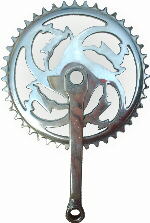 Gazelle chainset Gazelle chainset
|
|
| Mobilisation and motorization |
In the fifties and sixties, an enormous
mobilisation of the society took place. In the first post-war years there was a
significant demand for bicycles. The total number of bicycles in Holland had fallen under
two million during the war. The moped, which was introduced in 1948, became particularly
popular in the fifties whereas in the sixties the car showed a remarkable boost in
production figures: between 1960 en 1968 the number of cars driving in the Netherlands
increased from half a million up to two million.

Nevertheless, Dutch bicycle exports grew significantly
through-out the sixties. Germany was an important destination, but Dutch companies also
started exploring the American market. Because of the upcoming influence of the common
EEC-market, foreign companies could enter the Dutch market more easily. However, for the
time being at least, Dutch manufacturers managed to retain about three quarters of the
home market.

While turnover figures increased, the number of
manufacturers and dealers declined. The trade journal "De Nederlandsche
Rijwielhandel" wrote in the early sixties:
|
The problem of the Dutch bicycle
industry is the relatively small scale of the companies which are therefore not able to
compete on international markets. |
The sixties became a
period of increased expansion and competition, with a number of companies closing down
while others merged or were taken over. In 1961 there were 45 companies which mounted
self-built frames to bicycles or mopeds. This number declined to 42 companies in 1962, 39
in 1964, down to 36 companies in 1966. Some milestones of the concentration during the
sixties:
| 1961 |
Phoenix takes over
Fongers, |
|
Pon acquires the Burgers
brand |
| 1962 |
Phoenix-Fongers takes over
Germaan, |
|
Primarius cycle works is
closed |
| 1965 |
merger of
Simplex-Locomotief and Juncker |
| 1966 |
Union starts cooperation
with Kaptein |
| 1967 |
Veeno closed after
bankruptcy |
| 1968 |
Gazelle takes over
Juncker-Locomotief-Simplex, |
|
Stokvis closes Nederlandse
Kroon |
| 1969 |
Batavus takes over Magneet |
| 1970 |
Batavus takes over
Phoenix-Fongers-Germaan |
The changes in the quality
of the bicycles between 1960 and 1970 are an indicator of what was going on in this
industry. While cheaper production of bicycles was a pure necessity, buyers no longer
required heavy, durable bicycles. This makes the sixties a cut-off period, whereafter
thoroughly built, durable bicycles became scarce.
|
| Boring seventies - roaring eighties |
The 1970's represent a rather staid
period in which little changed both technically and design wise. During the eighties
cycling became more fashionable. With mountainbiking as initial trend, technical aspects
of other types of bikes also improved. Buyers became willing to pay more money for their
bicycle. But contemporary bicycles are still not meant to last for more than a limited
number of years. And while the quality of bicycles of the upper section of the market
increases, the quality of bicycles in the lower, bargain market continues to deteriorate.
|
| Some figures |
Nowadays there are just a few bicycle
manufacturers left in Holland. Of the well-know old brands Gazelle, Batavus, Union and
Sparta have managed to survive. Batavus now produces about 400,000 units per year. It
outstripped Gazelle as the biggest selling bicycle manufacturer in Holland. Moreover, in
october 1999 the Batavus group took over Sparta (annual production: 70,000 bicycles).

The entire Dutch bicycle branch employs about 9,000 people,
1,250 of which are working with bicycle manufacturers. There are almost 3,000 recognised
bicycle retailers left. In 1970 this number was 6,000 and in 1948 there were 12,000 of
them.

In Holland more than 1 million bicycles are sold per year, a
little under half of which are imported. The main export destination is Germany. The total
number of bicycles in Holland is now about 16 million.
|
Copyright by
Herbert Kuner, © 1999 ...
All rights reserved.

Last update: 07/06/2002
|